History
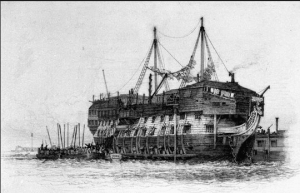 The reasons that Britain decided to start a Penal Colony at Botany Bay, Australia are not fully agreed upon. Some say that that there were deeper motives than just a place to house their criminals. The soil at Botany Bay was perfect for growing flax. I suppose that the prisoners would need to be doing some kind of work as penance for their crimes. Nevertheless, Britain would be making a profit from the flax that was produced thee, and the bay was perfect for a port, which would be necessary to assist with trade. All in all, Botany Bay seemed like the best option for a penal colony for Britain, so the plans were put in place, and before long the penal colony became a reality.
The reasons that Britain decided to start a Penal Colony at Botany Bay, Australia are not fully agreed upon. Some say that that there were deeper motives than just a place to house their criminals. The soil at Botany Bay was perfect for growing flax. I suppose that the prisoners would need to be doing some kind of work as penance for their crimes. Nevertheless, Britain would be making a profit from the flax that was produced thee, and the bay was perfect for a port, which would be necessary to assist with trade. All in all, Botany Bay seemed like the best option for a penal colony for Britain, so the plans were put in place, and before long the penal colony became a reality.
When Governor Phillip arrived in 1788, he asked for carpenters, masons, bricklayers to help set up the colony, along with many tools of the trades. In January of 1788, the first 736 convicts banished from England to Australia arrived in Botany Bay. Over the next 60 years, approximately 50,000 criminals were transported from Great Britain to the Botany Bay in one of the strangest episodes in criminal-justice history. I think many of us have thought that some criminals should be place on a deserted island, but Britain basically did just that…with every criminal, it seems.
The accepted wisdom of the upper and ruling classes in 18th century England was that criminals were inherently defective. They did not believe criminals could be rehabilitated and that they simply required separation from the genetically pure, law-abiding citizens. Consequently, lawbreakers had to be either killed or exiled, because prisons were too expensive, and they criminals were not worth the money. With the American victory in the Revolutionary War, transgressors could no longer be shipped off across the Atlantic, so the English had to look for a colony in some other direction.
Captain Arthur Phillip, a tough but fair career naval officer, was charged with setting up the first penal colony in Australia. The convicts were chained beneath the deck during the entire hellish six-month voyage. The first voyage claimed the lives of nearly 10 percent of the prisoners, which remarkably proved to be a rather good rate. On later trips, up to a third of the unwilling passengers died on the way. These were not hardened criminals by any measure; only a small minority were transported for violent offenses. Among the first group was a 70-year-old woman who had stolen cheese to eat.
Although not confined behind bars, most convicts in Australia had an extremely tough life. The guards who volunteered for duty in Australia seemed to be driven by exceptional sadism. Even small violations of the rules could result in a punishment of 100 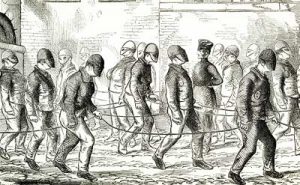 lashes with a whip. It was said that blood was usually drawn after five lashes, but they didn’t stop there. Convicts usually ended up walking home in boots filled with their own blood, if they could walk at all. Convicts who attempted to escape were sent to tiny Norfolk Island, 600 miles east of Australia. The conditions there were even more inhumane. The only hope of escape from the horror of Norfolk Island was a “game” in which groups of three prisoners drew straws. The short straw was killed as painlessly as possible and a judge was then shipped in to put the other two on trial, one playing the role of killer, the other as witness. I guess the only hope of escape was, in reality, death. There were no second chances for them.
lashes with a whip. It was said that blood was usually drawn after five lashes, but they didn’t stop there. Convicts usually ended up walking home in boots filled with their own blood, if they could walk at all. Convicts who attempted to escape were sent to tiny Norfolk Island, 600 miles east of Australia. The conditions there were even more inhumane. The only hope of escape from the horror of Norfolk Island was a “game” in which groups of three prisoners drew straws. The short straw was killed as painlessly as possible and a judge was then shipped in to put the other two on trial, one playing the role of killer, the other as witness. I guess the only hope of escape was, in reality, death. There were no second chances for them.
 Most of us think of Saint Patrick’s day as a day to celebrate being Irish, and to celebrate even if you aren’t Irish. But this day is actually dedicated to a man who was considered legendary by the Irish people. Born in Great Britain, probably in Scotland, to a well-to-do Christian family of Roman citizenship, Patrick was captured and enslaved at age 16 by Irish marauders. For the next six years, he worked as a herder in Ireland, turning to a deepening religious faith for comfort. Following the counsel of a voice he heard in a dream one night, he escaped and found passage on a ship to Britain, where he was eventually reunited with his family.
Most of us think of Saint Patrick’s day as a day to celebrate being Irish, and to celebrate even if you aren’t Irish. But this day is actually dedicated to a man who was considered legendary by the Irish people. Born in Great Britain, probably in Scotland, to a well-to-do Christian family of Roman citizenship, Patrick was captured and enslaved at age 16 by Irish marauders. For the next six years, he worked as a herder in Ireland, turning to a deepening religious faith for comfort. Following the counsel of a voice he heard in a dream one night, he escaped and found passage on a ship to Britain, where he was eventually reunited with his family.
Much of what is known about Patrick’s legendary life comes from a book he wrote during his last years, called the Confessio. According to the Confessio, while in Britain, Patrick had another dream, in which an individual named Victoricus gave him a letter. The letter was entitled “The Voice of the Irish.” As he read it, Patrick seemed to hear the voices of Irishmen pleading him to return to their country and walk among them once more. After studying for the priesthood, Patrick was ordained a bishop. He arrived in Ireland in 433 and began preaching the Gospel, converting many thousands of Irish and building churches around the country. After 40 years of living in poverty, teaching, traveling, and working tirelessly, Patrick died on March 17, 461 in Saul,  where he had built his first church.
where he had built his first church.
Since Patrick’s passing, countless legends have grown up around him. The Irish made him the patron saint of Ireland. They say he baptized hundreds of people on a single day, and that he used a three-leaf clover…the famous shamrock…to describe the Holy Trinity. He is often portrayed in art as trampling on snakes, a picture that came with the belief that he drove those reptiles out of Ireland. For thousands of years, the Irish have observed the day of Saint Patrick’s death as a religious holiday, attending church in the morning and celebrating with food and drink in the afternoon. It was a day to be thankful for the man who bought them to the Lord. As holidays often do, the ways of celebrating changed over the years. The first St. Patrick’s Day parade took place not in Ireland, but the United States, when Irish soldiers serving in the English military marched through New York City in 1762. I’m sure they were doing their best to keep with the tradition of their country. As the years went on, the parades became a show of unity and strength for persecuted Irish-American  immigrants, and then a popular celebration of Irish-American heritage.
immigrants, and then a popular celebration of Irish-American heritage.
The rest of the world observed it differently…probably due to the Irish tourism’s efforts to promote their country. The party went global in 1995, when the Irish government began a large-scale campaign to market Saint Patrick’s Day as a way of driving tourism and showcasing Ireland’s many charms to the rest of the world. Today, March 17 is a day of international celebration, as millions of people around the globe put on their best green clothing to drink beer, watch parades and toast the luck of the Irish, but it was never really about luck, you know…it was about blessing. Happy Saint Patrick’s day…and cheers!!
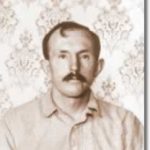 The old West as a wild place with very little law enforcement, and there was a lot of distance between lawmen. That also left room for may forms of lawlessness. I can’t say for sure that the gun for hire started in the old West, but it seems plausible. One such “gun for hire” was Thomas “Tom” Horn Jr, who often used the alias of James Hicks. Horn was born in Memphis, Missouri on November 21, 1860. He would become one of the most celebrated hired guns of the Old West, winning national fame for his freelance work, due in large part to his autobiography. Nevertheless, he wound up on the gallows for practicing his trade.
The old West as a wild place with very little law enforcement, and there was a lot of distance between lawmen. That also left room for may forms of lawlessness. I can’t say for sure that the gun for hire started in the old West, but it seems plausible. One such “gun for hire” was Thomas “Tom” Horn Jr, who often used the alias of James Hicks. Horn was born in Memphis, Missouri on November 21, 1860. He would become one of the most celebrated hired guns of the Old West, winning national fame for his freelance work, due in large part to his autobiography. Nevertheless, he wound up on the gallows for practicing his trade.
Tom was the fifth of 12 children, and his father, Tom Horn Sr, was a strict disciplinarian. Apparently, Tom didn’t like his dad’s strict ways, so he ran away in 1874 at the age of 14. Horn headed west…first to Santa Fe, then on to Arizona. By the time he was 15, he was an army scout and involved in many campaigns for more than a decade, including Geronimo’s surrender in 1886, in which Horn said he played a major role. During that time he also learned Spanish. As to his own account, Horn writing that he played a big role in the surrender of Geronimo, many historians doubt that, and actual accounts of that day indicate that Tom was there solely as a Spanish to English interpreter. After the surrender of Geronimo, Horn was discharged as a scout and reportedly mined for a while in Aravaipa, Arizona. Other than his autobiography, little is known about this period of his life for sure. We know that he was involved somehow with the Pleasant Valley War between Arizona cattlemen and sheepmen, but for which side is not clear.
It was during this time he decided to give law enforcement a try. In 1890, after proving himself during a short stint as a deputy sheriff in Arizona, Horn joined the Pinkerton Agency as a roving gunman, and using his gun with lethal effectiveness, tracked down dozens of outlaws, reputedly killing 17 men. He was pressured to resign by the agency, even though he was respected as a tracker. It seemed that with Horn came bad publicity. Horn decided to go it alone as a cattle detective, turning up in Wyoming in 1894 working for the beef barons. Horn denied killing anyone for the Pinkertons. Nevertheless, he was offering the same lethal services to the cattlemen, who were engulfed in what is known as the Johnson County War. As a “Stock Detective”, for each cattle rustler he shot, he charged $500-$600 and proved himself to be a methodical manhunter and ruthless killer. Horn once said “Killing men is my specialty. I look at it as a business proposition, and I think I have a corner on the market.”
After a short stint in Tampa, Florida working as a packer during the Spanish American War in 1898, Horn contacted Malaria and once mended, he headed back to Wyoming and returned to his dealings as a “gun for hire”. Records show that he was hired to stop cattle rustling in Brown’s Hole, Colorado in 1900, at which time he was going by the name James Hicks. He would boast in a letter, “I stopped cow stealing in one summer”, 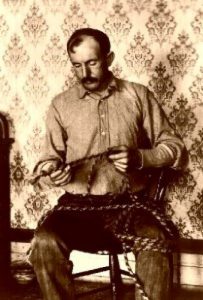 this being after he killed two area ranchers and scared the rest of the rustlers out of the area. In mid July, 1901, William Nickell, the 14 year old son of a sheep rancher, was ambushed and killed in the Iron Mountain region, allegedly due to a case of mistaken identity, as the bullet was meant for his father. About a week later, the boy’s father, Kels Nickell, was shot in the arm and hip during another ambush. U.S. Deputy Marshal Joe LeFors suspected Horn’s involvement. LeFors, wanting to gain a confession out of Horn, pretended to be in need of someone to take on a rustler clean up job in Montana. During this famous interview, Horn admitted to the Nickell’s shootings, not knowing that there was a court reporter hiding and taking notes. Ultimately, the interview would be his undoing. Although Horn alleged at his trial that he was drunk during the interview, he was found guilty on October 23, 1902, with the Wyoming State Supreme Court denying him a new trial. He was sentenced to hang, which was carried out in Cheyenne, Wyoming on November 20, 1903.
this being after he killed two area ranchers and scared the rest of the rustlers out of the area. In mid July, 1901, William Nickell, the 14 year old son of a sheep rancher, was ambushed and killed in the Iron Mountain region, allegedly due to a case of mistaken identity, as the bullet was meant for his father. About a week later, the boy’s father, Kels Nickell, was shot in the arm and hip during another ambush. U.S. Deputy Marshal Joe LeFors suspected Horn’s involvement. LeFors, wanting to gain a confession out of Horn, pretended to be in need of someone to take on a rustler clean up job in Montana. During this famous interview, Horn admitted to the Nickell’s shootings, not knowing that there was a court reporter hiding and taking notes. Ultimately, the interview would be his undoing. Although Horn alleged at his trial that he was drunk during the interview, he was found guilty on October 23, 1902, with the Wyoming State Supreme Court denying him a new trial. He was sentenced to hang, which was carried out in Cheyenne, Wyoming on November 20, 1903.
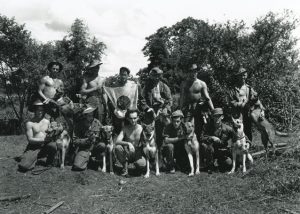 Dogs have long been used in everything from rescue to law enforcement. In fact, their use easily dates back to the 14th century. Dogs have a keen sense of smell, and the ability to be trained to track things that are lost. They were very good in every form of rescue, tracking, and even law enforcement activities, but they weren’t really used for law enforcement.
Dogs have long been used in everything from rescue to law enforcement. In fact, their use easily dates back to the 14th century. Dogs have a keen sense of smell, and the ability to be trained to track things that are lost. They were very good in every form of rescue, tracking, and even law enforcement activities, but they weren’t really used for law enforcement.
Then, on March 13, 1942, the Quartermaster Corps (QMC) of the United States Army began training dogs for the newly established War Dog Program, also known as the “K-9 Corps.” Over a million dogs served on both sides during World War I, carrying messages along the complex network of trenches and also providing some measure of psychological comfort to the soldiers. There is nothing better than petting a dog to make you feel all warm and fuzzy. The most famous dog to emerge from the war was Rin Tin Tin, an abandoned puppy of German war dogs found in France in 1918 and taken to the United States, where he made his film debut in the 1922 silent film The Man from Hell’s River. As the first bona fide animal movie star, Rin Tin Tin made the little-known German Shepherd breed famous across the country.
In the United States, the practice of training dogs for military purposes was, for the most part, abandoned after World War I. When the country entered World War II in December 1941, the American Kennel Association and a group called Dogs for Defense began a movement to mobilize dog owners to donate healthy and capable animals to the Quartermaster Corps of the U.S. Army. Training began in March 1942, and that fall the Quartermaster Corps was given the task of training dogs for the U.S. Navy, Marines and Coast Guard as well.
The K-9 Corps initially accepted over 30 breeds of dogs, but the list was soon narrowed to seven: German Shepherds, Belgian sheep dogs, Doberman Pinschers, Collies, Siberian Huskies, Malumutes, and Eskimo dogs. 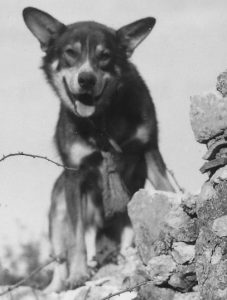 Members of the K-9 Corps were trained for a total of 8 to 12 weeks. After basic obedience training, they were sent through one of four specialized programs to prepare them for work as sentry dogs, scout or patrol dogs, messenger dogs, or mine-detection dogs. In active combat duty, scout dogs proved especially essential by alerting patrols to the approach of the enemy and preventing surprise attacks.
Members of the K-9 Corps were trained for a total of 8 to 12 weeks. After basic obedience training, they were sent through one of four specialized programs to prepare them for work as sentry dogs, scout or patrol dogs, messenger dogs, or mine-detection dogs. In active combat duty, scout dogs proved especially essential by alerting patrols to the approach of the enemy and preventing surprise attacks.
The top canine hero of World War II was Chips, a German Shepherd who served with the Army’s 3rd Infantry Division. Trained as a sentry dog, Chips broke away from his handlers and attacked an enemy machine gun nest in Italy, forcing the entire crew to surrender. The wounded Chips was awarded the Distinguished Service Cross, Silver Star and the Purple Heart–all of which were later revoked due to an Army policy preventing official commendation of animals. Then, 71 years after his death, Chips’ medals were restored to him. He was always a hero, now the world knew it too.
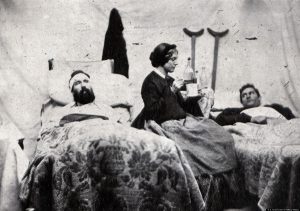 When we think of our nation’s early wars, and really, up until the Persian Gulf War, soldiers were officially men only. Prior to the Persian Gulf War, any women who were in combat were disguised as men, or they were in non-combat roles, such as support staff and nurses. Few women were recognized for their service, much less honored for it, but on March 12, 1776, in Baltimore, Maryland, someone decided to change the way we looked at the effort made by women in wars. And when I say effort know that I include much sacrifice.
When we think of our nation’s early wars, and really, up until the Persian Gulf War, soldiers were officially men only. Prior to the Persian Gulf War, any women who were in combat were disguised as men, or they were in non-combat roles, such as support staff and nurses. Few women were recognized for their service, much less honored for it, but on March 12, 1776, in Baltimore, Maryland, someone decided to change the way we looked at the effort made by women in wars. And when I say effort know that I include much sacrifice.
That day, a public notice appeared in local papers recognizing the sacrifice of women to the cause of the revolution. The notice urged others to recognize women’s contributions as well, and announced, “The necessity of taking all imaginable care of those who may happen to be wounded in the country’s cause, urges us to address our humane ladies, to lend us their kind assistance in furnishing us with linen rags and old sheeting, for bandages.” On and off the battlefield, women were known to support the revolutionary cause by providing nursing assistance. But donating bandages and sometimes applying them was only one form of aid provided by the women of the new United States. From the earliest protests against British taxation, women’s assent and labor 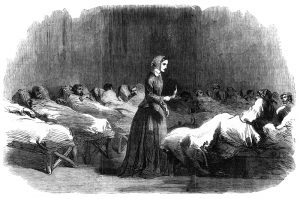 was critical to the success of the cause. The boycotts that united the colonies against British taxation required female participation far more than male participation, in fact, the men designing the non-importation agreements chose to boycott products used mostly by women…how thoughtful of them!!
was critical to the success of the cause. The boycotts that united the colonies against British taxation required female participation far more than male participation, in fact, the men designing the non-importation agreements chose to boycott products used mostly by women…how thoughtful of them!!
Tea and cloth are perhaps the best examples of these boycotted products. While most schoolchildren have read of the men who dressed as Mohawk Indians and dumped large volumes of tea into Boston Harbor at the Boston Tea Party, as a form of opposition to the hated Tea Act, few realize that women…not men…drank most of the tea in colonial America. Samuel Adams and his friends may have dumped the tea in the harbor, but they were far more likely to drink rum than tea when they returned to their homes. Conveniently, their actions actually deprived their wives, mothers, sisters and daughters, and not themselves. The colonists only resorted to an attempted boycott of rum in 1774, after Britain had closed the port of Boston. I guess it was time for drastic measures.
Similarly, when John Adams and other men in power thought it best to stop importing fine British fabrics with 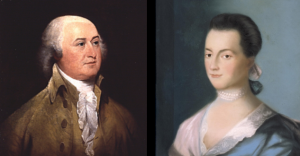 which to make their clothing during the protests of the late 1760s, it had little impact on their daily lives. Wearing homespun cloth may not have been as comfortable nor look as refined as their regular clothing, but it was Abigail and other colonial wives and homemakers, not John and his fellow men, who were forced to spend hours spinning clothes to create their families’ wardrobes. Thus, in 1776, when Abigail begged John to remember the ladies while drafting the U.S. Constitution, she was not begging a favor, but demanding payment of an enduring debt. And her husband, in good conscience could not deny her right, or her important request.
which to make their clothing during the protests of the late 1760s, it had little impact on their daily lives. Wearing homespun cloth may not have been as comfortable nor look as refined as their regular clothing, but it was Abigail and other colonial wives and homemakers, not John and his fellow men, who were forced to spend hours spinning clothes to create their families’ wardrobes. Thus, in 1776, when Abigail begged John to remember the ladies while drafting the U.S. Constitution, she was not begging a favor, but demanding payment of an enduring debt. And her husband, in good conscience could not deny her right, or her important request.
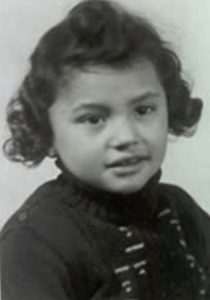 Yesterday, I had the unique opportunity to listen to a Holocaust survivor speak at a seminar. Her name was Inge Auerbacher, and she was an amazing woman. Inge was the last Jewish child born in Kippenheim, a village in South Western Germany located at the foot of the Black Forest. She was the only child of Berthold (1898–1987) and Regina Auerbacher (née Lauchheimer, 1905–1996). Both of her parents came from observant Jewish families who had lived for many generations in Germany. Her father proudly served in the German army, but when the Nazis came for them, his loyal service meant nothing to them. They were Jewish, and that fact condemned them to the concentration camps. Loyal service could not compensate for Hitler’s crazed hatred of the Jewish people.
Yesterday, I had the unique opportunity to listen to a Holocaust survivor speak at a seminar. Her name was Inge Auerbacher, and she was an amazing woman. Inge was the last Jewish child born in Kippenheim, a village in South Western Germany located at the foot of the Black Forest. She was the only child of Berthold (1898–1987) and Regina Auerbacher (née Lauchheimer, 1905–1996). Both of her parents came from observant Jewish families who had lived for many generations in Germany. Her father proudly served in the German army, but when the Nazis came for them, his loyal service meant nothing to them. They were Jewish, and that fact condemned them to the concentration camps. Loyal service could not compensate for Hitler’s crazed hatred of the Jewish people.
Inge had barely started school when her family as deported to Czechoslovakia and sentenced to the Terezin camp. When she and her parents went in, Inge was seven years old when she went into Terezin. She would be there for three years. I will not  say she called it home for three years, because it was definitely not a home. Inge tells of the companions she always knew would be there…the rats, mice, fleas, and bed bugs. The prisoners were allowed two showers a year…yes, I said a year. No wonder those companions hung around. Another occasional companion was lice which meant shaved heads to make removal easier. All of this was horrible, but it was the least of the nightmare. The guards gave brutal beatings…especially the women guards. The scientists performed experiments on the people, and they were given very little to eat. They were doing everything they could to kill their prisoners. Nevertheless, it was all too slow for Hitler.
say she called it home for three years, because it was definitely not a home. Inge tells of the companions she always knew would be there…the rats, mice, fleas, and bed bugs. The prisoners were allowed two showers a year…yes, I said a year. No wonder those companions hung around. Another occasional companion was lice which meant shaved heads to make removal easier. All of this was horrible, but it was the least of the nightmare. The guards gave brutal beatings…especially the women guards. The scientists performed experiments on the people, and they were given very little to eat. They were doing everything they could to kill their prisoners. Nevertheless, it was all too slow for Hitler.
A total of 140,000 people were shipped to Theresienstadt concentration camp near Terezin; 88,000 were sent primarily to the gas chambers in Auschwitz, and 35,000 died of malnutrition and disease in Terezin. Of the 15,000 children imprisoned in 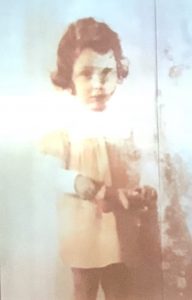 Terezin, Inge and her parents were among the 1% that survived. Her childhood friends, especially her best friend, Ruth lost her life at Auschwitz. Ruth’s father was half Christian and half Jewish. She was raised Christian, but it didn’t make a difference. She and her family were executed for their Jewish heritage. Poor Ruth was deported to Auschwitz in one of the last transports. Ruth and the other children marched with their parents to their final destination, not knowing what was to come. They were told they were going to the showers, but it was the gas chambers, and their parents would not tell them otherwise. It would have been far too cruel. For me, the picture that Inge found years later, of Ruth as a little girl, has stayed vividly in my mind. She was a sweet, innocent little girl, who had done nothing wrong, but her life was taken away from her because she was pat Jewish…because Hitler hated the Jewish people. Hate…an ugly word. Inge says that this type of treatment happens when people lose their humanity. She would tell you, “Never lose your humanity.”
Terezin, Inge and her parents were among the 1% that survived. Her childhood friends, especially her best friend, Ruth lost her life at Auschwitz. Ruth’s father was half Christian and half Jewish. She was raised Christian, but it didn’t make a difference. She and her family were executed for their Jewish heritage. Poor Ruth was deported to Auschwitz in one of the last transports. Ruth and the other children marched with their parents to their final destination, not knowing what was to come. They were told they were going to the showers, but it was the gas chambers, and their parents would not tell them otherwise. It would have been far too cruel. For me, the picture that Inge found years later, of Ruth as a little girl, has stayed vividly in my mind. She was a sweet, innocent little girl, who had done nothing wrong, but her life was taken away from her because she was pat Jewish…because Hitler hated the Jewish people. Hate…an ugly word. Inge says that this type of treatment happens when people lose their humanity. She would tell you, “Never lose your humanity.”
 First chronicled by the famous western writer, Zane Grey, in his 1934 novel The Code of the West, no “written” code ever actually existed. However, the hardy pioneers who lived in the west were bound by these unwritten rules that centered on hospitality, fair play, loyalty, and respect for the land. These days, little of that code remains, or so it seems. These days, the more someone can get away with, he better they seem to like it. That just wasn’t the case for the people of thee old West. They needed to know that they could count on their neighbors, friends, and yes, even strangers
First chronicled by the famous western writer, Zane Grey, in his 1934 novel The Code of the West, no “written” code ever actually existed. However, the hardy pioneers who lived in the west were bound by these unwritten rules that centered on hospitality, fair play, loyalty, and respect for the land. These days, little of that code remains, or so it seems. These days, the more someone can get away with, he better they seem to like it. That just wasn’t the case for the people of thee old West. They needed to know that they could count on their neighbors, friends, and yes, even strangers
Ramon Adams, a Western historian, explained it best in his 1969 book, The Cowman and His Code of Ethics, saying, in part: “Back in the days when the cowman with his herds made a new frontier, there was no law on the range. Lack of written law made it necessary for him to frame some of his own, thus developing a rule of behavior which became known as the “Code of the West.” These homespun laws, being merely a gentleman’s agreement to certain rules of conduct for survival, were never written into statutes, but were respected everywhere on the range.”
Though the cowman might break every law of the territory, state and federal government, he took pride in upholding his own unwritten code. His failure to abide by it did not bring formal punishment, but the man who broke it became, more or less, a social outcast. His friends “hazed him into the cutbacks” and he was subject to the punishment of the very code he had broken. Though the Code of the West was always unwritten, here is a “loose” list of some of the guidelines: Don’t inquire into a person’s past. Take the measure of a man for what he is today. Never steal another man’s horse. A horse thief pays with his life. Defend yourself whenever 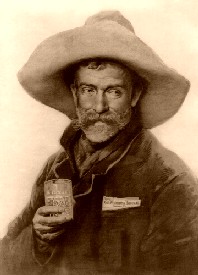 necessary. Look out for your own. Remove your guns before sitting at the dining table. Never order anything weaker than whiskey. Don’t make a threat without expecting dire consequences. Never pass anyone on the trail without saying “Howdy”. When approaching someone from behind, give a loud greeting before you get within shooting range. Don’t wave at a man on a horse, as it might spook the horse. A nod is the proper greeting. After you pass someone on the trail, don’t look back at him…it implies you don’t trust him. Riding another man’s horse without his permission is nearly as bad as making love to his wife. Never even bother another man’s horse. Always fill your whiskey glass to the brim. A cowboy doesn’t talk much; he saves his breath for breathing. No matter how weary and hungry you are after a long day in the saddle, always tend to your horse’s needs before your own, and get your horse some feed before you eat. Cuss all you want, but only around men, horses and cows. Complain about the cooking and you become the cook. Always drink your whiskey with your gun hand, to show your friendly intentions. Do not practice ingratitude. A cowboy is pleasant even when out of sorts. Complaining is what quitters do, and cowboys hate quitters. Always be courageous. Cowards aren’t tolerated in any outfit worth its salt. A cowboy always helps someone in need, even a stranger or an enemy. Never try on another man’s hat. Be hospitable to strangers. Anyone who wanders in, including an enemy, is welcome at the dinner table. The same was true for riders who joined cowboys on the range. Give your enemy a fighting chance. Never wake another man by shaking or touching him, as he might wake suddenly and shoot you. Real cowboys are modest. A braggart who is “all gurgle and no guts” is not tolerated. Be there for a friend when he needs you. Drinking on duty is grounds for instant dismissal and blacklisting. A cowboy is loyal to his “brand,” to his friends, and those he rides with. Never shoot an unarmed or unwarned enemy. This was also known as “the rattlesnake code”: always warn before you strike. However, if a man was being stalked, this could be ignored. Never shoot a woman no matter what.
necessary. Look out for your own. Remove your guns before sitting at the dining table. Never order anything weaker than whiskey. Don’t make a threat without expecting dire consequences. Never pass anyone on the trail without saying “Howdy”. When approaching someone from behind, give a loud greeting before you get within shooting range. Don’t wave at a man on a horse, as it might spook the horse. A nod is the proper greeting. After you pass someone on the trail, don’t look back at him…it implies you don’t trust him. Riding another man’s horse without his permission is nearly as bad as making love to his wife. Never even bother another man’s horse. Always fill your whiskey glass to the brim. A cowboy doesn’t talk much; he saves his breath for breathing. No matter how weary and hungry you are after a long day in the saddle, always tend to your horse’s needs before your own, and get your horse some feed before you eat. Cuss all you want, but only around men, horses and cows. Complain about the cooking and you become the cook. Always drink your whiskey with your gun hand, to show your friendly intentions. Do not practice ingratitude. A cowboy is pleasant even when out of sorts. Complaining is what quitters do, and cowboys hate quitters. Always be courageous. Cowards aren’t tolerated in any outfit worth its salt. A cowboy always helps someone in need, even a stranger or an enemy. Never try on another man’s hat. Be hospitable to strangers. Anyone who wanders in, including an enemy, is welcome at the dinner table. The same was true for riders who joined cowboys on the range. Give your enemy a fighting chance. Never wake another man by shaking or touching him, as he might wake suddenly and shoot you. Real cowboys are modest. A braggart who is “all gurgle and no guts” is not tolerated. Be there for a friend when he needs you. Drinking on duty is grounds for instant dismissal and blacklisting. A cowboy is loyal to his “brand,” to his friends, and those he rides with. Never shoot an unarmed or unwarned enemy. This was also known as “the rattlesnake code”: always warn before you strike. However, if a man was being stalked, this could be ignored. Never shoot a woman no matter what.
Consideration for others is central to the code, such as: Don’t stir up dust around the chuck wagon, don’t wake  up the wrong man for herd duty, etc. Respect the land and the environment by not smoking in hazardous fire areas, disfiguring rocks, trees, or other natural areas. Honesty is absolute – your word is your bond, a handshake is more binding than a contract. Live by the Golden Rule. “The Code of the West was a gentleman’s agreement to certain rules of conduct. It was never written into the statutes, but it was respected everywhere on the range.“ Ramon F. Adams
up the wrong man for herd duty, etc. Respect the land and the environment by not smoking in hazardous fire areas, disfiguring rocks, trees, or other natural areas. Honesty is absolute – your word is your bond, a handshake is more binding than a contract. Live by the Golden Rule. “The Code of the West was a gentleman’s agreement to certain rules of conduct. It was never written into the statutes, but it was respected everywhere on the range.“ Ramon F. Adams
As I read through these “codes,” I have to think just how sad it is that so little of that beautiful code is practiced these days, and how very sad that is.
 Anyone who lived through the 1960s knows about the Hippie Counterculture, or as we called it the Hippie Generation. It seems that every generation must be named. I wonder what the people who named Generation X would have called the Hippie Generation. In many ways they were much the same, with the exception of their clothes, anyway.
Anyone who lived through the 1960s knows about the Hippie Counterculture, or as we called it the Hippie Generation. It seems that every generation must be named. I wonder what the people who named Generation X would have called the Hippie Generation. In many ways they were much the same, with the exception of their clothes, anyway.
There was something that was unique, in my mind, to the Hippie Generation, and that was the Volkswagen Bus. I’m sure it was a coincidence that the VW Bus came out about the time that the whole “free love” ear was happening, but I would think that it was every parents nightmare, because it supplied a rolling motel room for kids on dates, and remember that the parents were pretty much against the whole “free love” thing. In fact, I’m quite sure it totally terrified them, because not only were their girls dating this guy was a rolling motel room, but this guy was…well, very different from the kind of man they had always hope their daughter would marry. My son-in-law, Kevin Petersen grew up around vans. His parents were at the right age to really be a part of the Hippie Generation, although I don’t know if they were really involved or not. They did love vans, however, and fixed theirs up to show.
The VW Bus, for it’s part, was the brainchild of Dutch businessman Ben Pon, an importer of the Volkswagen Beetles to the Netherlands. Pon saw a market for a small bus and in 1947 sketched out his concept. The bus went into production on March 8, 1950…technically before the Hippie Generation, so I suppose the Hippies adopted the VW Bus, and not the other way around. Known officially as the Volkswagen Type 2 (the Beetle was the Type 1) or the Transporter, the bus was a favorite mode of transportation for hippies in the United States during the 1960s and became an icon of the American counterculture movement. The bus eventually collected a number of nicknames, including the “Combi” (for combined-use vehicle) and the “Splittie” (for its split windshield); in Germany it was known as the “Bulli.” In the United States it was referred to by some as a hippie van or bus because it was used to transport groups of young people and their camping gear and other supplies to concerts and anti-war rallies. Some owners painted colorful murals on their buses and replaced the VW logo on the front with a peace symbol.
The Volkswagen Bus was only the second vehicle built by Volkswagen, a company whose history dates back to the 1930s Germany. In 1933, Adolf Hitler became chancellor of Germany and announced he wanted to build new roads and affordable cars for the German people. At that time, Austrian-born engineer Ferdinand Porsche (1875-1951) was already working on creating a small car for the masses. Hitler and Porsche later met and the engineer was charged with designing the inexpensive, mass-produced Volkswagen, or “people’s car.” In 1938, work began on the Volkswagen factory, located in what is now Wolfsburg, Germany. Full-scale vehicle  production didn’t begin until after World War II, however. In the 1950s, the Volkswagen arrived in the United States, where the initial reception was negative, due in part to the car’s historic Nazi connection as well as its small size and unusual rounded shape (which later led to it being dubbed the “Beetle”). In 1959, the advertising agency Doyle Dane Bernbach launched a groundbreaking campaign that promoted the car’s diminutive size as a distinct advantage to consumers, and over the next several years Volkswagen became the top-selling auto import in the United States. In 1972, the VW Beetle passed the Ford Model T as the world’s best-selling car, with over 15 million vehicles produced.
production didn’t begin until after World War II, however. In the 1950s, the Volkswagen arrived in the United States, where the initial reception was negative, due in part to the car’s historic Nazi connection as well as its small size and unusual rounded shape (which later led to it being dubbed the “Beetle”). In 1959, the advertising agency Doyle Dane Bernbach launched a groundbreaking campaign that promoted the car’s diminutive size as a distinct advantage to consumers, and over the next several years Volkswagen became the top-selling auto import in the United States. In 1972, the VW Beetle passed the Ford Model T as the world’s best-selling car, with over 15 million vehicles produced.
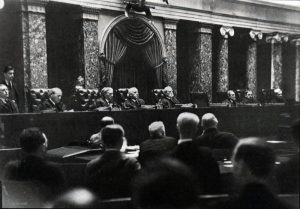 Have you ever seen a picture of a Supreme Court session? Probably not. Photography is banned in Supreme Court, and there are only two known photographs of the Supreme Court in session. Cameras have long been banned inside the courtroom, so the only two photos were captured many decades ago by people who snuck cameras in.
Have you ever seen a picture of a Supreme Court session? Probably not. Photography is banned in Supreme Court, and there are only two known photographs of the Supreme Court in session. Cameras have long been banned inside the courtroom, so the only two photos were captured many decades ago by people who snuck cameras in.
The first photo, shown above, was shot in 1932 by a German photographer named Erich Salomon. Salomon was hired by Fortune magazine to shoot images during a tour of America. The photographer decided to sneak a camera into the Supreme Court by faking that he had a broken arm so that he could hide his camera inside his sling. Salomon was able to snap a stealthy photo, which was later published in Fortune and touted as the first photo ever made showing the court in session. That as a pretty sneaky way to get a camera into the courtroom, and while I don’t know how security is at the Supreme Court these days, but it wouldn’t surprise me to see a guard looking inside a sling to see what someone was trying to bring inside.
I can understand how a camera could be a problem, especially with old cameras. Many of them required a flash for indoor pictures, and having flashes going off all the time would be very distracting. Also, with today’s phones and cameras, videos could be taken easily, with sound that could let people outside the courtroom know about what was going inside the courtroom.
Nevertheless, five years later, in 1937, a young woman managed to take a second photo of the Supreme Court in session. This second photo was published in the June 7, 1937, edition of Time magazine, within an article titled Judiciary: Farewell Appearance. Time magazine wrote at the time, that the photo was taken by “an enterprising amateur, a young woman who concealed her small camera in her handbag, cutting a hole through which the lens peeped, resembling an ornament. She practiced shooting from the hip, without using the camera’s finder which was inside the purse.” The photographer was never named and remains a mystery to this day. The photo was also the first and only time all 9 justices of the court appeared in the same photo in session. There are rumors of a third photo of the Supreme court in session that was taken and published around the same time, but there does not appear to be any surviving record of that image.
Then, 77 years later, the inevitable happened. In 2014, an advocacy group snuck a camera into the Supreme Court and filmed the first-ever footage of the US Supreme Court in session. They captured a video that’s about 2-minutes long: The Supreme Court has officially banned cameras since 1946 when Federal Rule 53 was  enacted. It reads: Except as otherwise provided by a statute or these rules, the court must not permit the taking of photographs in the courtroom during judicial proceedings or the broadcasting of judicial proceedings from the courtroom. While Supreme Court justices have long been opposed to cameras in the courtroom, believing that cameras adversely impact the dynamic of the proceedings, they have been softening their stance in recent years. A number of justices have warmed up to the idea of cameras in the courtroom, possibly paving the way for a rule change in the future. I don’t know if I think that is a good thing or not, but somehow it seems that when you tell people they can’t do something, they ultimately find a way.
enacted. It reads: Except as otherwise provided by a statute or these rules, the court must not permit the taking of photographs in the courtroom during judicial proceedings or the broadcasting of judicial proceedings from the courtroom. While Supreme Court justices have long been opposed to cameras in the courtroom, believing that cameras adversely impact the dynamic of the proceedings, they have been softening their stance in recent years. A number of justices have warmed up to the idea of cameras in the courtroom, possibly paving the way for a rule change in the future. I don’t know if I think that is a good thing or not, but somehow it seems that when you tell people they can’t do something, they ultimately find a way.
 “Every state has ghost towns. Eastern and Midwestern States are no exception. At one time or another you may have driven your car right by a ghost town, not aware of it. If you are a hiker, backpacker, or a hunter, you may have walked past or through a ghost town not knowing one was there.” I read that statement on a web site I was using to research stories for my blog. I had read many stories about ghost towns, but this one intrigued me. My husband, Bob Schulenberg and I have hiked many of the trails in the Black Hills, and I can’t even begin to count the number of times we have walked past old abandoned, crumbling, falling down buildings. To us, they seemed like just an abandoned farmhouse and out buildings, but now I am beginning to wonder if we have been one of those hikers who have walked right through a ghost town, and didn’t even know it. In fact, I’ll bet we have walked right through many a ghost town during our many hikes.
“Every state has ghost towns. Eastern and Midwestern States are no exception. At one time or another you may have driven your car right by a ghost town, not aware of it. If you are a hiker, backpacker, or a hunter, you may have walked past or through a ghost town not knowing one was there.” I read that statement on a web site I was using to research stories for my blog. I had read many stories about ghost towns, but this one intrigued me. My husband, Bob Schulenberg and I have hiked many of the trails in the Black Hills, and I can’t even begin to count the number of times we have walked past old abandoned, crumbling, falling down buildings. To us, they seemed like just an abandoned farmhouse and out buildings, but now I am beginning to wonder if we have been one of those hikers who have walked right through a ghost town, and didn’t even know it. In fact, I’ll bet we have walked right through many a ghost town during our many hikes.
I love photographing old buildings, and often find myself wondering how long they had been there, and why 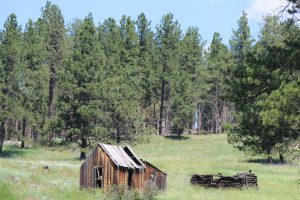 they were left to rot. Of course, the Black Hills is rich in gold rush history, so a ghost town or tow makes perfect sense. We have driven through, and by some of them, and even passed through some while riding he 1880 Train, but for some reason, it didn’t occur to me that some of the old buildings we have hiked by could have been part of a ghost town, but looking back now, it makes perfect sense. I have often found myself wondering who lived there and what their lives might have been like back when the house was newly built. Still, it didn’t occur to me that it might be part of a ghost town. I guess that is because I always thought that all the ghost towns would be well documented with signs alerting the tourists to the site. In reality, those signs would be placed by the town’s owner, who was trying to make a buck by romanticizing the site…and that’s ok too, but that doesn’t mean that every ghost town was so well documented. In reality, it’s the ghost towns that are less documented that hold the most intrigue, because much less is known about them.
they were left to rot. Of course, the Black Hills is rich in gold rush history, so a ghost town or tow makes perfect sense. We have driven through, and by some of them, and even passed through some while riding he 1880 Train, but for some reason, it didn’t occur to me that some of the old buildings we have hiked by could have been part of a ghost town, but looking back now, it makes perfect sense. I have often found myself wondering who lived there and what their lives might have been like back when the house was newly built. Still, it didn’t occur to me that it might be part of a ghost town. I guess that is because I always thought that all the ghost towns would be well documented with signs alerting the tourists to the site. In reality, those signs would be placed by the town’s owner, who was trying to make a buck by romanticizing the site…and that’s ok too, but that doesn’t mean that every ghost town was so well documented. In reality, it’s the ghost towns that are less documented that hold the most intrigue, because much less is known about them.
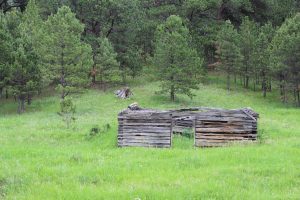 I think that the next time we hike and find ourselves passing by an old rotting building, that I will feel much different about the place than I did in the past. I think I will still wonder about who lived there, but also about whether or not it was a ghost town that once sprung up, and prospered, only to be choked out when hard times hit and the people who lived there moved on in search of a better life. That was, after all, the fate of every ghost town. It was a town that sprung up with the promise of becoming a bustling city, but it was in the wrong place, and life could not be sustained there, so eventually it withered and died off, leaving only the buildings to tell of its presence, and then only to those who happened to pass by.
I think that the next time we hike and find ourselves passing by an old rotting building, that I will feel much different about the place than I did in the past. I think I will still wonder about who lived there, but also about whether or not it was a ghost town that once sprung up, and prospered, only to be choked out when hard times hit and the people who lived there moved on in search of a better life. That was, after all, the fate of every ghost town. It was a town that sprung up with the promise of becoming a bustling city, but it was in the wrong place, and life could not be sustained there, so eventually it withered and died off, leaving only the buildings to tell of its presence, and then only to those who happened to pass by.

